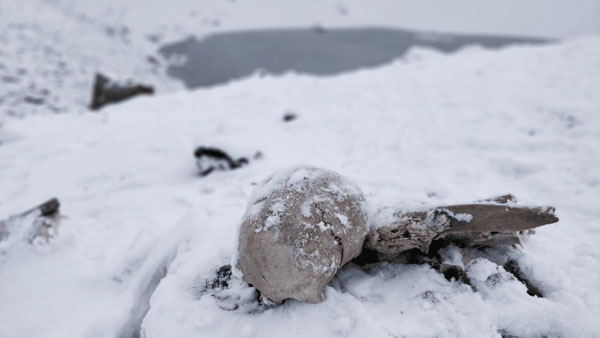By Satyabrat Borah
In the vast, unforgiving expanse of Antarctica, where temperatures plunge to minus 89 degrees Celsius and winds howl across endless ice fields, the discovery of human remains feels like a whisper from a forgotten era. On January 7, 1985, Chilean biologist Daniel Torres Navarro knelt on the pebbled shore of Yámana Beach at Cape Shirreff, on Livingston Island in the South Shetland Islands. What began as a routine collection of marine debris turned into a moment that would rewrite fragments of history. Half-buried in the rocky sand, eroded by relentless waves and frost, lay a human cranium, its empty sockets staring out at the Southern Ocean. This was no ordinary find. It was the oldest known human remains ever unearthed on the continent, dated to between 1819 and 1825, predating the first confirmed sighting of Antarctica’s mainland by just a year or two.
Torres Navarro, a professor of biology and natural sciences at the University of Chile, froze in disbelief. The skull, weathered but intact, showed no immediate signs of violence or decay beyond what the environment could inflict. He documented the exact time, 16:35, and location with meticulous care, knowing that in such a remote place, context was everything. A frantic search of the surrounding beach yielded two loose teeth, but nothing more, no mandible, no vertebrae, no clues to connect this fragment to a body or a story. The absence amplified the mystery. Why here, on this desolate strip of land named after the indigenous Yámana people of Tierra del Fuego? And how had a human soul ventured so far south, into a realm then unknown to the world?
Scientific analysis soon painted a portrait of the individual behind the bones. The cranium belonged to a young woman, approximately 21 years old, of mestizo descent, with features suggesting origins in the southern channels of Chile. Anthropometric measurements revealed a slender build, adapted perhaps to the rugged fjords and archipelagos near Cape Horn, but ill-suited to Antarctica’s brutality. Signs of nutritional stress etched into the bone, alongside evidence of anemia and an external ear infection, spoke of hardship even before her arrival. Dental wear indicated a diet heavy on coarse foods, typical of coastal indigenous communities. Yet, no artifacts accompanied her, no tools, clothing remnants, or sealskin boots to hint at her fate. DNA testing, proposed in early studies, aimed to link her to femurs found nearby in 1988 and 1993, but even those efforts left gaps. She was a ghost in the ice, her presence defying the tidy timelines of exploration history.
To understand this enigma, one must rewind to the early 19th century, a time when Antarctica hovered on the edge of the known world. European powers, driven by curiosity and commerce, pushed southward in search of new routes and riches. The fur seal trade exploded around 1819, drawing rugged sealers from Britain, America, and beyond to the South Shetlands. Ships like the Essex and the San Telmo braved the Drake Passage, that churning gateway between South America and the Antarctic Peninsula, where waves tower like mountains and gales shred sails. The San Telmo, a Spanish vessel carrying reinforcements to Peru, vanished in September 1819 after striking ice near the Shetlands. Wreckage washed ashore on Livingston Island in 1820, discovered by British explorer William Smith, who claimed the land for King George. Amid the splintered timbers, rumors swirled of survivors, perhaps clinging to debris, glimpsing the icy continent before succumbing.
Could this woman have been among them? The timeline fits eerily. Her death, estimated via bone preservation and sediment layers, aligns with the San Telmo’s demise. Perhaps she was a passenger, a crew member’s companion, or even an indigenous guide from Chile’s southern tribes, bartered or coerced aboard for her knowledge of treacherous waters. The Yámana people, skilled navigators in their cedar canoes, knew the subantarctic seas intimately, hunting seals and trading across the Beagle Channel. Oral histories among the Kawésqar and Yámana speak of voyages pushed by storms, landing on islands now lost to maps. But Antarctica? That was the edge of myth, a place of spirits and endless night. If she crossed the Drake on a sealer, what role did she play? Stoker in the engine room? Interpreter for a captain eyeing uncharted bays? Or was she a victim of the era’s shadows, trafficked in the underbelly of maritime trade, her life expendable in the hunt for pelts worth fortunes in London markets?
Theories abound, each more speculative than the last. One posits she drowned during a shipwreck and washed ashore, her body currents carrying southward like driftwood. The South Shetlands, dotted with coves that trap debris from the passage, support this. Another suggests abandonment, a grim practice not unknown among desperate crews facing scurvy or mutiny. Nutritional stress in her bones hints at prolonged deprivation, perhaps weeks adrift on rations of hardtack and brackish water. Ear infection could stem from exposure, the cold seeping into wounds from gales. Yet, no ship logs mention her. The sealing fleets operated in secrecy, evading rivals and patrols, their manifests listing only able-bodied men. Women, especially indigenous ones, vanished from records like footnotes. This silence fuels the defiance of her discovery. She predates Bellingshausen’s 1820 sighting of the ice shelf, and even Smith’s earlier glimpse of the Shetlands in 1819. If confirmed as a living visitor, she upends narratives of white explorers as firsts, injecting indigenous agency into the frozen south.
Recent scholarship amplifies the intrigue. A 1999 study in the International Journal of Osteoarchaeology detailed her pathology, linking it to broader patterns of colonial-era suffering. Echoes appear in The Lancet’s 1999 analysis of Tierra del Fuego remains, tracing migration routes from Asia across the Americas, suggesting southern peoples adapted to cold long before Europeans arrived. Journal of Archaeological Science papers on prehistoric seafaring propose Polynesian or Patagonian voyages reaching subantarctic latitudes millennia ago, though evidence remains scant. In 2025, as climate thaw exposes more relics, her story resonates anew. Melting permafrost on the Shetlands has revealed ship nails and boot heels from the 1820s, but no other humans. Torres Navarro, now in his later years, reflects on the find as a “chain of events” forever broken. “Only those remains have been found to this day,” he wrote, a poignant admission of limits.
This discovery ripples beyond academia, touching geopolitics in a continent governed by the 1959 Antarctic Treaty. Nations like Chile, Argentina, and Britain claim overlapping sectors, citing historical presence. The woman’s Chilean origins bolster Santiago’s case, her bones a subtle artifact in negotiations. As the treaty faces review in 2030, archaeology becomes diplomacy’s quiet weapon. “When remains or objects are found in the ice, it inflates territorial nationalism,” notes geographer Klaus Dodds. Chile’s Antarctic Institute has repatriated the skull to Santiago, where it rests in a climate-controlled vault, studied but not displayed, lest it stir sensitivities. Indigenous groups in Tierra del Fuego, descendants of the Yámana, view her not as a relic but a kin, demanding ethical repatriation and narrative control. Her story challenges erasure, reminding that exploration’s victors wrote the maps, but the vanquished left bones.
Four decades on, the young woman’s cranium endures as Antarctica’s most baffling heirloom. She embodies the continent’s dual nature: a graveyard of ambition, where Scott’s 1912 tragedy and Amundsen’s triumph play out in ice, and a canvas for human resilience. In an age of satellite views and research stations humming with solar power, her mystery persists. How did she arrive, and what did she see in those final, frozen hours? Did she glimpse the aurora’s green veil, or hear the calving thunder of glaciers? Perhaps she whispered prayers in Selk’nam tongue to the wind. Science offers fragments, but explanation eludes. In defying tidy answers, she humanizes the ice, proving that even in Earth’s coldest corner, lives once burned bright, fierce, and fleeting. As global warming nibbles at the shores where she washed up, her remains urge us to listen closer to the silences of history, before they too dissolve into the sea.




